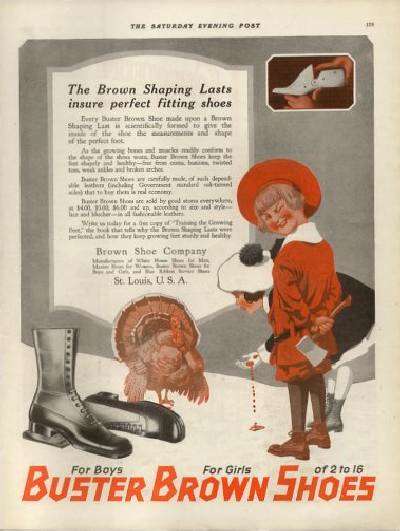
Buster Brown Shoes

Figure 1.-- This is an original 1919 print ad for Buster Brown Shoes from 'The Saturday Evening Post'. This particular ad offers shoe lasts. The ad is unusual because Buster was rarely pictured with high-top shoes. Perhaps this was because the ad was for lasts and high-top shoes were still widely worn.
|
|
The Brown Shoe Company renamed itself the Buster Brown Shoe Company. The Company introduced Buster Brown Shoes to the public in 1904 during the St. Louis World's Fair. Bush went on to become president of the firm in 1915 and Chairman of the Board in 1948. Bush promoted the brand with national print, radio, outdoor, and eventually television advertising. We notice ads in major magazines of the era. Here is a 1919 ad from The Saturday Evening Post (figure 1). The ad is unusual because Buster was rarely picturd with high-top shoes. Perhaps this was because the ad was for lasts and high-top shoes were still widely worn. Buster Brown Shoes was the single most important shoe company in America. It played a major role in shifting children's shoe styles from high-top to low cut shoe. The company came out with a line of sturdy oxfords for boys. They named the strap shoes that both Buster and Mary Jane wore as 'Mary Janes'. We are not sure just when they did this. The name stuck with the public and Mary Janes became an American term for strap shoes and a staple in any well-dressed little girl's wardrobe. Here we see a Bustern Brown ad with these low-cut styles (figure 2).
Corporate History
The Brown Shoe Company renamed itself the Buster Brown Shoe Company. The Company introduced Buster Brown Shoes to the public in 1904 during the St. Louis World's Fair. Bush went on to become president of the firm in 1915 and Chairman of the Board in 1948. Bush promoted the brand with national print, radio, outdoor, and eventually television advertising. We notice ads in major magazines of the era.
Products
Here is a 1919 ad from The Saturday Evening Post (figure 1). The ad is unusual because Buster was rarely picturd with high-top shoes. Perhaps this was because the ad was for lasts and high-top shoes were still widely worn.

Figure 2.--This Buster Brown ad shows the styles for which the company becme famous. he magzine and ate re shown, but we can not make them out, perhaps the early-1920s. (The quality of the color printing suggests the 1920s to us rather thn the 1910s which ws our initil assessmnt. A reader writes, "It's 'The Ladies Home Journal'. but I can't make out the date. It might be the teens." We can see 'Home Journl', but can't make out the word before it.
|
|
Importance
Buster Brown Shoes have been called the single most important shoe company in America. It played a major role in shifting children's shoe styles from high-top to low cut shoe. The company came out with a line of sturdy oxfords for boys. They named the strap shoes that both Buster and Mary Jane wore as 'Mary Janes'. We are not sure, however, just when they did this. The name stuck with the public and Mary Janes became an American term for strap shoes and a staple in any well-dressed little girl's wardrobe. Here we see a Bustern Brown ad with these low-cut styles, but unfortunately cannot yet date it (figure 2). A reader writes, "The Brown Shoe Co. as you ay bought the right to use Buster Brown Comics characters in 1904 at the World's Fair, but so did the company that made Mary Jane Candy (which is still made). I thought there might be a connection between the girl on the wrapper of the candy who also wears Mary Jane shoes. But I haven't been able to find any proof one way or the other. Of course Mary Jane like Buster in the comic wears strap shoes."
Assessment
A reader writes, "I have done extensive research on this subject and cannot find evidence that the Brown Shoe Co. named strap shoes 'Mary Janes'. I certainly don't think they would have done this while boys were wearing the style. The first example I found was a 'Mary Jane Pump' in 1912 or 1913 for women, not children, during the tango craze. The strap helped hold the shoe on the foot during this fast dance. And this was an ankle strap not an instep strap shoe. If you have any documented evidence on the origin of the term Mary Jane Shoes, please let me know." Very interesting. What we wtote bove seems to be the consensus on various internet sites, but without proper domunentation. I do know that Buster Brown first appeared in 1902 and was licensed by Brown in 1904. I'm not sure if Mary Jane appered from the beginning or later, but surely it was well before 1912. Now just when the shoe began to be called Mary Jane, we are not sure. Your point that children, including boys were wearing them is well taken. Wewill keep our eyes opened for any helpful details.
HBC

Navigate the Boys' Historical Clothing Web Site:
[Return to the Main Buster Brown Company page]
[Introduction]
[Activities]
[Biographies]
[Chronology]
[Cloth and textiles]
[Clothing styles]
[Countries]
[Topics]
[Bibliographies]
[Contributions]
[FAQs]
[Glossaries]
[Images]
[Glossaries]
[Images]
[Links]
[Registration]
[Tools]
[Tools]
[Boys' Clothing Home]
Navigate the Boys' Historical Clothing Web Site:
[Sailor hats]
[Sailor suits]
[Buster Brown suits]
[Eton suits]
[Rompers]
[Tunics]
[Smocks]
[Pinafores]
Created: 11:11 PM 4/20/2007
Last updated: 7:51 AM 2/28/2015




